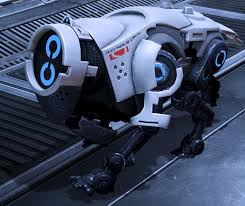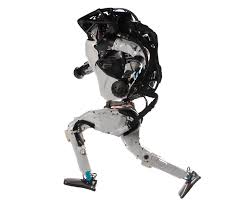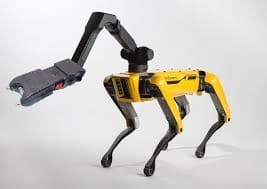Mass Effect 2. One of my favourite games, growing up, (and like, 20 minutes ago). In which the now legendary Commander Shepard dies, gets rebuilt, and then goes on to collect the most badass team of badasses to go do badass things. First, however, you have to get through a bunch of Portal-turrets-given-legs looking guys in the tutorial missions. These are what the game refers to as a mech, though they’re not the Battletech brand of ‘Mech. Really, they’re just robots. (And if you’ve ever played Battletech, you know how thankful you should be).

But here I am, popping mechanical heads, watching them explode, and I notice how…simple they are. It makes sense, they’re an early game enemy, they’re not supposed to be challenging. All these “mechs” can do is walk towards you and shoot. They don’t seem to be capable of any kind of complex navigation, and unlike the other major synthetic enemies, the geth, they use pretty much zero tactics. How hard can that be?
Now, it’s pretty obvious we’re at least a little while off from building proper, robot apocalypse A.I. like the Geth, but how far are we from building these simpler, less complex combat robots?
Sci-Fi – The Mechs
First, let’s discuss which mechs we’re talking about, and which games. For simplicity, I’m going to restrict my discussion to Mass Effect 2’s Loki, Fenris, and Ymir mechs. Then I’ll discuss the major parts of these kinds of machines, and try to apply those to anything in the real world that might be similar. I’ll spend a little time here describing the mechs in-game so that the uninitiated know what’s happening.
The LOKI
The Loki mech is a humanoid, bipedal robot. It is armoured, and sealed against water and other environmental hazards. They’re often used as “disposable” combatants on the shiftier side of the law. They’re usually armed with a pistol or submachine gun and have an EMP pulse they use against melee range enemies (which I will henceforth ignore entirely, for the purposes of the article.)

The FENRIS
The Fenris mech is a type of quadruped robot that is often seen as analogous to “attack dogs”. They’re heavily armoured and have advanced sensory equipment to be used as “sniffer dogs”. In combat, they will close in on enemy combatants and pounce on them before delivering a taser-like shock.
 The YMIR
The YMIR
A massive killing machine. The Ymir is a bipedal robot, a veritable walking tank with heavy armour, automatic cannons and a high explosive missile launcher. They’re used as infantry support and often appear beside the Loki variants. In combat, they will pin their enemy down with oppressive fire and close to negate their enemy’s cover.
Reality – The Hardware
Initially, it seems ridiculous to think that we’re anywhere even close to creating sci-fi robots like these. I mean, sure, we have robot vacumes and stuff, but a walking, shooting robot? C’mon, that’s fantasy talk. That is until you take a peek at Boston Dynamics’ youtube channel.
 LOKI = The ATLAS
LOKI = The ATLAS
This is ATLAS, a robot made by Boston dynamics that is designed to be used as a search and rescue operator in environments too dangerous for humans to safely operate, being able to navigate unstable, uneven terrain, and manipulate a variety of devices designed for humans.
It was inspired by the Fukushima nuclear disaster when thousands of elderly Japanese citizens volunteered to brave the radiation exclusion zone in place of younger workers. Sacrificing themselves to spare the younger generation from cancer in their later years. This is heartwarming, and heroic, but also tragic. Using platforms like ATLAS, it wouldn’t need to be done at all.
In a bit of irony, Atlas here is already much more nimble than its sci-fi counterpart. Sure, it doesn’t have armour but we’ve got one hundred and fifty years to get there. This is, for all intents and purposes, a Loki mech. I couldn’t find a price tag, but considering R&D plus manufacturing, it likely does not check the “disposable” box that the Loki does.
Having said that, if you combine the ATLAS’s mobility with FEDOR, an (unsurprisingly) Russian robot that can shoot guns, you get a Loki mech… From a hardware perspective, we’re already there. (though, unlike ATLAS, there is very little information on FEDOR, and knowing Russia, they’re probably not as far along as they claim).
Scary, isn’t it?
 FENRIS = SPOT
FENRIS = SPOT
Again, we return to Boston Dynamics. And again, we find an eerily complete version in the real world. Meet Spot, a Boston Dynamics robot that can be programmed with any number of tasks. It can be given a variety of power sensory equipment and can be tasked with patrolling or monitoring a location or place.
It has everything from audio sensors to detect abnormal operation noise in machinery, to visually inspecting areas for damage. It can also be given an arm.
I mean, there’s not much to say here. SPOT is a quadrupedal robot with advanced sensory equipment that can be used to remotely patrol a variety of areas when human workers cannot go or would be otherwise unwilling. All you have to do is strap a taser to that creepy little arm and you’ve got a Fenris mech. “You mess with doggo, you get the zappo.”

YMIR = The Landwalker (?)
Surprisingly, and thankfully, Boston Dynamics is not working on a giant, walking tank with machine guns and missiles, (yet). So I had to put a little more work into finding a suitable analog for a real-world YMIR.
I started looking for just big walking machines, just looking for a proof of concept that something that big could actually be made to walk.
Enter the Landwalker. A machine built, perhaps unsurprisingly, by the Japanese company Sakakibara Kikai, who normally build large scale farming equipment. The Landwalker is a 3.4m (11ft) tall walking, pilotable exoskeleton. Oh, and it comes with guns, (not real guns, they fire rubber or plastic balls, but still).
This does make it much more analogous to the Mass Effect 3 enemy, a pilotable robot called… ATLAS… But as I said, we’re sticking to ME 2, and having two robots called ATLAS is already confusing me. While the Landwalker lacks the refinement of the Atlas and Spot robots (also the robotics), they are a big, mobile weapons platform with legs. So it’s close enough for my purposes. The top speed leaves a little to be desired (1.5km/hr), but it’s at least a proof of concept.
Do you know what the best part is? Sakakibara rents these out for kid’s parties. What kind of absolute legend can say, “There’s a bouncy castle, a punch bowl, a ball pit, and oh yeah, an 11ft robot tank you can drive.” Though I’m not sure how comfortable I’d be with my child driving it as this is how it looks like when it “walks”.
On another “big-ass robot” note, an engineer from the Sakakibara company built an entire damn Gundam that you can also pilot. Its slower than the Landwalker, and I can only pray it’s not commercially available. But it can manipulate its fingers, it’s got a gun and it’s 8.5 meters tall. Jesus Christ, Japan.
The Software
The software needed to run something like these robots is the kind that sits firmly in the realm of A.I.; this will be intelligence that will have to have a certain amount of autonomy in decision making that is immensely complicated and difficult to implement. I can’t say we have something exactly like this in the pipeline, but mostly because there isn’t a need for one. What we are working on, however, is self-driving cars.
Self-driving cars are machines that will have to be able to sense their surroundings in a fast-paced and dynamic setting while making decisions that will impact the lives and safety of organic beings around them. Call me crazy, but that sounds like a soldier’s description as well.
There are plenty of companies that are developing self-driving car technology, but none are being quite as open as Tesla is. Tesla CEO Elon Musk first mentioned the car’s potential ability for self-driving in 2013. Now, in 2020, we are definitely seeing the results of progressive steps in that direction, with successive versions of hardware and software packages that are slowly increasing that car’s ability to drive autonomously. Lane tracking, self-parking, and limited navigation capabilities.
We’re not quite there yet. But as Elon Musk said, the automation is “really a software limitation: The hardware exists to create full autonomy, so it’s really about developing advanced, narrow AI for the car to operate on.”
There will likely be no Starshot breakthrough that will suddenly make this all possible in the software. But time, money, and a lot of iterations will give us exactly what we need. Probably long before the time period in which Mass Effect is set.
The Power
Power – the king resource of our world. Generating and storing it are massive industries that are responsible for much of the technological progression, for better or worse, of our species.
These things will need power, and it seems obvious that we should just put batteries on them, like a Telsa. But what isn’t obvious, is the problem of weight.
Specific Energy refers to how much energy a source has per mass unit, in this case, megajoules per kilogram. Simply put, it’s how dense the energy source is.
Lithium-ion batteries, like the kind used by Electric Vehicles (EVs), have a specific energy of 0.36–0.875 MJ/kg. For every kilogram of battery, you can get out a maximum of a little less than a megajoule. Not bad, right? WRONG. Standard gasoline, for a car, has a specific energy of 46.4 MJ/kg, about fifty-three times as energy-dense, which is one reason why EVs are so hard to make.
Spot has a current battery life of 90 minutes, depending on the task and the load it’s carrying. I couldn’t find any hard numbers for how long an ATLAS can go between charges, but when it participated in the DARPA robotics competition, it had a time limit of an hour, which seems like a reasonable amount of time, given its complexity. I couldn’t figure out how long the Landwalker could go either, but it’s gas-powered, so it’s not really the same discussion.
Battery technology is a rapidly evolving field, with a lot of research being put into developing the next big thing, solid-state batteries. Current Lithium-ion batteries use a liquid or gel electrolyte to pass ions between an anode and the cathode. (It’s alright if you don’t know what this means, just look up how batteries work and you’ll figure it out). But solid-state batteries have, you guessed it, a solid electrolyte. This makes them much more stable and long-lasting than the liquid and gel electrolyte batteries. It also eliminates one of Lithium battery’s biggest drawback, dendrites.
When bits of the anode and cathode protrude out into the electrolyte and can sometimes reach the other side, resulting in a… spectacular end to the battery’s life. (if you’re interested you can find a video on the subject by a channel called Answers with Joe. He’s a cool guy that runs a cool, sciency channel, go check him out.)
But in the end, we do not have viable solid-state batteries yet, so we must make do with our current generation Li-Ion batteries, which are heavy, and can be dangerous if punctured or damaged. Which is a distinct possibility in a robot that’s probably going to be shot at quite a bit.
Power storage is the biggest roadblock to building these. To create effective, viable soldiers we’ll need a dense, stable power source that isn’t too heavy, and we just don’t have that yet.
We could just power it all with Gasoline. It worked for the Landwalker, it works for normal tanks, why not walking ones? Well, in part, we already have. DARPA’s Bigdog, an ancestor to the Spot robot, was implemented as a gas-powered robot designed to fit into a military squad. But the motor was too loud for tactical situations, and it saw only limited logistical use.
Though a YMIR/Landwalker sized mech would likely not suffer from that drawback, as its contemporary, the battle tank, doesn’t need stealth and already uses an internal combustion engine. Though I think we can all agree that using battery power is the gold standard. We’re going for Sci-fi, here, not diesel-punk.
But Should We?
The hardware is there. The software is on the way. Power is a bit of an issue, but we’re getting there. What else is left?
There’s the question of whether or not something like this is needed. Why build a walking tank when a tank is already a perfectly reasonable vehicle? To that, I would simply say that while it’s much more complicated and energy-intensive, locomotion via walking is so adaptable that it’s inevitable for military technology. Stories of generals taking their forces through rough and complex terrain are some of the most lauded stories in military history. Hannibal crossing the Alps, the Blitzkrieg through the Ardennes. The ability to walk makes roads much less needed for transportation.
There are also questions of Ethics. Remote and automated weaponry is no longer a subject of fiction. We have real versions, Unmanned Aerial Vehicles (UAVs), that raise some very complicated and troubling questions about the morality and ethics of combat. I’ll try to discuss some of the concepts I think would apply to our mechs.
Pretty much everyone agrees that killing is bad. Right? It’s a major tenant in most religions, there are laws against it, and it’s universally considered just a real jerk move to do it. But people kill a lot in wartime and aren’t considered criminals (by most people at least). The importance of your reason might play a part. Whatever you’re doing as part of a military is undoubtedly more important than a domestic incident, or someone just being unstable. But we punish vigilantes who kill people we know to be bad, so that doesn’t seem to fit.
Yale Law professor Paul W. Khan says that there is a “distinct morality of the battlefield,” in which, because soldiers have no say in when or where they fight, they cannot be considered at fault. And as they know the other side will oppose them, they are acting in self-defence of themselves and their fellows. Thereby making them morally innocent.
Now, if you can engage in combat using a remote weapon, where the operator is a continent away, is it moral for that person to take a life when they are in no danger themselves? I believe that using a remote weapon like this is no different morally than the moral distinction between using a sword or a bow. The only difference is the distance between the two combatants. But the concept of “riskless warfare” is one that many find discomforting or inherently immoral. That it is only morally acceptable to end another life if you yourself might be in mortal danger by not doing so.
There are other ethical complications with remote or autonomous weapons. Because an operator is distant from the target of violence, many say that this makes the weapons less discriminating, that the operators are less likely to express sympathy or empathy towards their enemy, like a flesh and blood soldier might. Advocates of remote weapons claim that advanced weapons systems will be more discriminating, better able to differentiate enemy combatants, which, having done a CAPTCHA recently, seems like a big ask for AI that can’t figure out what a bus is.
A significant problem that weapons like these pose is that it would enable a relatively small number of people to wage war against a much larger population. Traditional soldiers need to be convinced their war is just in order to fight. Even if you’re just counting on deployed personnel, that is likely hundreds of thousands of people who will need to believe that this conflict is worth fighting for.
With automated weaponry like the kind being discussed, that number can be reduced heavily to thousands, or maybe even hundreds of people; and when governments don’t have to worry about public backlash over sending their citizen’s mothers, fathers, sons, and daughters to fight and die far from home; it may make conflict even more likely.
These are all problems and questions that will likely have to be thought through before we truly begin to produce robots like this (or someone will just ignore it and build them anyway). I don’t know any of the answers, because I’m not sure there are any. Public opinion will change as time goes on and people become comfortable with different contexts; what is considered morally good changes with the times.
Now, we cannot think of an automated system being allowed to fire upon human targets, but will that change? We’re being increasingly comfortable with the concept of an AI making decisions that might affect our lives, (self-driving cars, the stock market, etc). Things change, ideas shift. The future might look more different ethically than it does technologically, or it might not move, and the choice to end human life will always be in the hands of another human
What’s this all mean?
So how far are we from being able to build the robots from Mass Effect? If we gathered all the brightest minds and companies: Boston Dynamics, battery experts, AI specialists, and a metric ass-load of lobbyists to push it through any objections in government, and you work them morning, noon and night for the most powerful and complex automated weapons systems in the world, they could probably have functioning prototypes in as little as 5 years.
But they’re not. They’re not looking to make weapons. Not only is it more complicated than strictly necessary, but it would also be prohibitively expensive. Someone will, and then the lessons learned by building robots like ATLAS will come into play. But automated weapons are more likely to be wheeled, naval, or aerial for the foreseeable future. They’re just easier methods of locomotion compared to walking. Not even mentioning the fact that any automate weapons put into the field would likely never have the “fire on sight” behaviours that the mechs from the game do. ( I mean, humans rarely do that themselves).
Having said that, a lot of the technology is there, and the stuff that isn’t there is on the way. If I had to guess, the problems with the batteries and the software could be resolved in as little as ten years.
Which means we’re only twenty years away from the armed robot apocalypse! What fun!
If you enjoyed this piece make sure to check out some of our other Science Behind The Game articles down below.
- The Science Behind XCOM: Psionics
- The Science Behind Control: Multiverse Chaos
- The Science Behind Reliving Memories: Animus from Assassin’s Creed
- The Science Behind Time Perception Drugs: Chronos from Katana Zero
- The Science Behind Cyberpunk 2077: Cybernetics in Fiction vs Real-life - August 13, 2021
- Mass Effect Legendary Edition – What’s Different? - July 3, 2021
- The Shore Review: A Lovecraftian Experience (Spoiler Free) - February 19, 2021



